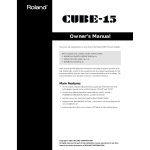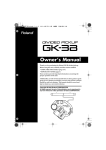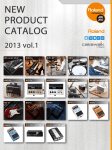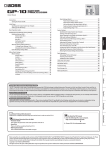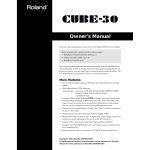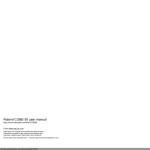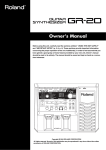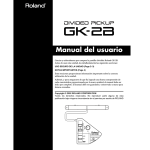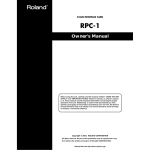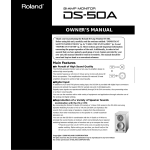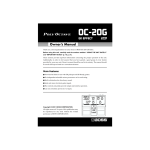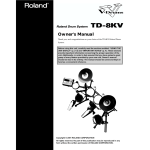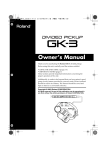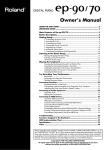Download GK-2B Manual
Transcript
Owner’s Manual Thank you for purchasing the Roland GK-2B divided pickup. Before using this unit, carefully read the sections entitled: USING THE UNIT SAFELY (Page 2–3) IMPORTANT NOTES (Page 4) These sections provide important information concerning the proper operation of the unit. Additionally, in order to feel assured that you have gained a good grasp of every feature provided by your new unit, Owner’s manual should be read in its entirety. The manual should be saved and kept on hand as a convenient reference. Copyright © 2002 ROLAND CORPORATION All rights reserved. No part of this publication may be reproduced in any form without the written permission of ROLAND CORPORATION. USING THE UNIT SAFELY The symbol alerts the user to important instructions or warnings.The specific meaning of the symbol is determined by the design contained within the triangle. In the case of the symbol at left, it is used for general cautions, warnings, or alerts to danger. Used for instructions intended to alert the user to the risk of death or severe injury should the unit be used improperly. Used for instructions intended to alert the user to the risk of injury or material damage should the unit be used improperly. The symbol alerts the user to items that must never be carried out (are forbidden). The specific thing that must not be done is indicated by the design contained within the circle. In the case of the symbol at left, it means that the unit must never be disassembled. * Material damage refers to damage or other adverse effects caused with respect to the home and all its furnishings, as well to domestic animals or pets. The ● symbol alerts the user to things that must be carried out. The specific thing that must be done is indicated by the design contained within the circle. In the case of the symbol at left, it means that the powercord plug must be unplugged from the outlet. 001 007 • Before using this unit, make sure to read the instructions below, and the Owner’s Manual. • Make sure you always have the unit placed so it is level and sure to remain stable. Never place it on stands that could wobble, or on inclined surfaces. .................................................................................................. 002a • Do not open or perform any internal modifications on the unit. .................................................................................................. 003 • Do not attempt to repair the unit, or replace parts within it (except when this manual provides specific instructions directing you to do so). Refer all servicing to your retailer, the nearest Roland Service Center, or an authorized Roland distributor, as listed on the “Information” page. .................................................................................................. 004 • Never use or store the unit in places that are: • Subject to temperature extremes (e.g., direct sunlight in an enclosed vehicle, near a heating duct, on top of heat-generating equipment); or are • Damp (e.g., baths, washrooms, on wet floors); or are • Humid; or are • Exposed to rain; or are • Dusty; or are • Subject to high levels of vibration. .................................................................................................. 2 .................................................................................................. 011 • Do not allow any objects (e.g., flammable material, coins, pins); or liquids of any kind (water, soft drinks, etc.) to penetrate the unit. .................................................................................................. 012d • Immediately turn the power off, and request servicing by your retailer, the nearest Roland Service Center, or an authorized Roland distributor, as listed on the “Information” page when: • Objects have fallen into, or liquid has been spilled onto the unit; or • The unit has been exposed to rain (or otherwise has become wet); or • The unit does not appear to operate normally or exhibits a marked change in performance. .................................................................................................. 013 • In households with small children, an adult should provide supervision until the child is capable of following all the rules essential for the safe operation of the unit. .................................................................................................. 014 • Protect the unit from strong impact. (Do not drop it!) .................................................................................................. 104 • Try to prevent cords and cables from becoming entangled. Also, all cords and cables should be placed so they are out of the reach of children. .................................................................................................. 106 • Never climb on top of, nor place heavy objects on the unit. .................................................................................................. 108c • Disconnect all cords coming from external devices before moving the unit. .................................................................................................. 118 • Should you remove the parts of installation, make sure to put them in a safe place out of children’s reach, so there is no chance of them being swallowed accidentally. .................................................................................................. For EU Countries This product complies with the requirements of European Directives EMC 89/336/EEC and LVD 73/23/EEC. 3 IMPORTANT NOTES 291a In addition to the items listed under “USING THE UNIT SAFELY” on page 2–3, please read and observe the following: Power Supply Maintenance 307 401a • Before connecting this unit to other devices, turn off the power to all units. This will help prevent malfunctions and/or damage to speakers or other devices. • For everyday cleaning wipe the unit with a soft, dry cloth or one that has been slightly dampened with water. To remove stubborn dirt, use a cloth impregnated with a mild, nonabrasive detergent. Afterwards, be sure to wipe the unit thoroughly with a soft, dry cloth. Placement 351 • Using the unit near power amplifiers (or other equipment containing large power transformers) may induce hum. To alleviate the problem, change the orientation of this unit; or move it farther away from the source of interference. 352b • Noise may be produced if wireless communications devices, such as cell phones, are operated in the vicinity of this unit. Such noise could occur when receiving or initiating a call, or while conversing. Should you experience such problems, you should relocate such wireless devices so they are at a greater distance from this unit, or switch them off. 354a • Do not expose the unit to direct sunlight, place it near devices that radiate heat, leave it inside an enclosed vehicle, or otherwise subject it to temperature extremes. Excessive heat can deform or discolor the unit. 355 • To avoid possible breakdown, do not use the unit in a wet area, such as an area exposed to rain or other moisture. 402 • Never use benzine, thinners, alcohol or solvents of any kind, to avoid the possibility of discoloration and/or deformation. Additional Precautions 553 • Use a reasonable amount of care when using the unit’s buttons, sliders, or other controls; and when using its jacks and connectors. Rough handling can lead to malfunctions. 556 • When connecting / disconnecting all cables, grasp the connector itself—never pull on the cable. This way you will avoid causing shorts, or damage to the cable’s internal elements. 558b • To avoid disturbing your neighbors, try to keep the unit’s volume at reasonable levels (especially when it is late at night). 559a • When you need to transport the unit, package it in the box (including padding) that it came in, if possible. Otherwise, you will need to use equivalent packaging materials. 928 * When turning the bass with GK-2B upsidedown, get a bunch of newspapers or magazines, and place them under the four corners or at both ends to prevent damage to the buttons and controls. Also, you should try to orient the unit so no buttons or controls get damaged. 929 * When turning the bass with GK-2B upsidedown, handle with care to avoid dropping it, or allowing it to fall or tip over. 4 CONTENTS USING THE UNIT SAFELY ...................2 IMPORTANT NOTES ............................4 Main Features .......................................5 About the GK-2B’s warranty .............. 5 Names of Things and What They Do ........6 Attaching the GK-2B to Your Bass.....8 Cautions for installation ...................... 8 Installation procedure.............................8 Attachment examples .............................9 1. Adjusting the divided pickup ...... 11 2. Attaching the divided pickup....... 12 Attaching the pickup with double-sided tape .........................12 Attaching the pickup with screws ......16 3. Attaching the controller................. 17 Attaching the controller with double-sided tape or velcro ........17 Attaching the controller with screws.............................................18 Operation ............................................19 Main Features The GK-2B is a divided pickup designed especially for bass. You can attach it to a conventional bass and play the GK-compatible device for bass from your instrument. ● Since the divided pickup contains six small pickups, it can support basses with up to six strings. ● The divided pickup allows you to make adjustments for optimal performance with basses of the distance between each string of 16 mm–19 mm. ● Tape and spacers for attaching the controller are included, making it easy to attach the GK2B securely to your bass. About the GK-2B’s warranty Roland guarantees the GK-2B (and all included parts) to be free of defects in materials and workmanship. Contact your retailer or nearest Roland Service Center if repairs become necessary. Roland cannot be responsible for any damage caused to your bass or the GK-2B as a result of your attempt to install or remove the GK-2B. If you are not confident with your ability to properly install the Pickup or Controller unit (especially where drilling is involved), please contact your Roland retailer or nearest Roland Service Center. Getting connected............................... 19 Main Specifications............................21 5 Names of Things and What They Do fig.01 (1) Divided Pickup (4) Normal Pickup Input Jack (3) Power Indicator (5) GK Connector (2) GK Volume Center Marker (8) S2 Switch (7) S1 Switch Pickup (6) Select Switch Controller (1) Divided pickup (4) Normal pickup input jack This is a pickup that senses the vibration of the bass strings. Attach it by the bridge of your bass. Use this jack to input the signal of the normal pickup of your bass into the GK-2B. Use the normal bass cable (included) to make this connection. (2) GK volume The function of the GK volume will differ depending on the GK-compatible device it is used with. Please refer to the owner's manual for your GK-compatible device. (3) Power indicator This indicator will light when the GK-2B is connected to a GK-compatible device via a GK cable. 6 (5) GK connector Use this connector to connect the GK-2B to a GK-compatible device. Names of Things and What They Do (6) Select switch This switch selects the sound that is output from the connected GK-compatible device. In the “BASS” position, the normal pickup sound of the bass will be output. In the “MIX” position, the normal pickup sound of the bass and the sound of the GK-compatible device will be mixed and output. In the “GK” position, the sound of the GK-compatible device will be output. For details, refer to the owner’s manual for your GK-compatible device. (7) S1 switch (8) S2 switch The functions of the S1/S2 switches differ depending on the GK-compatible device you are using. For details, refer to the owner’s manual for your GK-compatible device. 7 Attaching the GK-2B to Your Bass To use the GK-2B, you need to install it onto a conventional electric bass. It is not difficult to install the GK-2B, but please read the following items carefully before you begin, since there are several things that you should be aware of regarding how to attach the divided pickup and controller. Cautions for installation ● Do not use the GK-2B on a bass that has an unconventional string configuration, a bass with strings that have no steel core (e.g., nylon strings), or on a guitar. It will not function correctly. ● Adjustments to the neck of your bass, the string height, and intonation adjustments must be completed before attaching the GK-2B. ● Before you actually install the divided pickup and controller, place them against your bass to verify that there will be no problems with installation. ● We recommend that you use double-sided tape (not screws) to attach the controller first. Then after you have played your instrument to verify that there are no problems, use screws to attach it permanently. ● If the GK-2B is attached only with doublesided tape or velcro fastener, it may be dislodged by being jarred while you perform, or due to the tape loosing its stickiness over time. Also, depending on the finish (e.g., lacquer) of your instrument, and the condition of the finished surface (cracks, peeling), some of the finish may also peel off when the tape comes off. Please use the double-sided tape for temporarily fastening the GK-2B while deciding on its permanent location, and use the velcro fastener if you will be frequently attaching and detaching the controller. ● Depending on the type of your bass, it may be impossible to install the divided pickup because the space between the bridge and pickup is too narrow. In this case, it may be possible to install the GK-2B by modifying your bass (i.e., moving the pickup). Please consult your dealer. 8 ■ Installation procedure 1. Carefully read this manual, and decide the approximate locations in which you’re going to place the divided pickup and controller, and how you’re going to route the cable. 2. Adjust the divided pickup as appropriate for your bass. 3. Attach the divided pickup to your bass. 4. Attach the controller to your bass. 5. Connect the GK-2B to your GK-compatible device. 6. On the GK-compatible device, adjust the sensitivity of the pickup. * In order to play a GK-compatible device using the GK-2B, you must adjust the divided pickup to match the distance between each string, adjust the height of the divided pickup, and adjust the sensitivity on the GK-compatible device. These adjustments are extremely important if you hope to take full advantage of the performance of the GK-compatible device. For the adjustment procedure, refer to the manual of your GKcompatible device after you have finished reading this manual. Attaching the GK-2B to Your Bass ■ Attachment examples fig.40_e example 1 example 2 example 3 9 Attaching the GK-2B to Your Bass Make sure that you have all of the following parts required for installation. fig.02_e Tapping Flat 3 x 16 mm Pickup Cushion x 1 (for installing the Controller) x2 (for installing the Divided Pickup) Tapping Pan 3 x 20 mm x2 (for installing the Divided Pickup) Pickup Spacer A Spring x 10 (for installing the Divided Pickup) x2 (for installing the Divided Pickup) Controller Spacer Pickup Spacer B x 3 (for installing the Controller) x 10 (for installing the Divided Pickup) Double-sided Tape A x 3 (for installing the Controller) Velcro Fastener x 1 (for installing the Controller) Double-sided Tape B x4 (for installing the Divided Pickup) Double-sided Tape Cable Fook x 2 (for installing the Controller) x2 Normal Bass Cable Double-sided Tape (easily peeled) x2 (for installing the Divided Pickup) 10 x1 Screwdriver x1 Clearance Gauge x1 Attaching the GK-2B to Your Bass 1. Adjusting the divided pickup In the case of basses, the distance between each string differs between instruments, so you will need to adjust the divided pickup according to the distance between each string of your bass. Unless this adjustment is made accurately, the GK-compatible device will not function at its full potential, or may not operate correctly. Please make this adjustment with care. 1. Measure the distance between strings on your bass. To determine the distance between each string, you can measure the distance between string 1 and string 4 (or depending on the number of strings, 5 or 6) at the location in which to install the pickup (p.13–14), and divide by one less than the number of strings (i.e., in the case of a four-string bass, divide by three). 2. Use the included screwdriver to loosen the screws, move the markers to the position of the appropriate the distance between each string, and tighten the screws. * Be careful not to tighten the screws excessively. fig.04_e 2nd string marker loose tight 5th string marker loose tight fig.03_e 19 18 17 16 mm 16 17 18 19 mm 4 3 2 1 String Position * This adjustment made so that both left and right sides are at the same position. center center Measure the distance between these two strings. Example: * Be careful when moving the markers; do not use excessive force. Be especially careful with those at both sides of the bridge and head. fig.05 a distance of 57 mm 57 divided by (4-1) = 19 mm A gauge with pitches of 16, 17, 18, and 19 mm is printed on the GK-2B package, and you can also determine the spacing by placing this gauge against your bass. fig.52 11 Attaching the GK-2B to Your Bass 2. Attaching the divided pickup The divided pickup can be attached in one of two ways: ● Using double-sided tape ● Using screws Using double-sided tape is the easier method, and is generally recommended. Using screws has the advantage that you will be able to adjust the distance between the strings and pickup when necessary, but the procedure is somewhat more difficult than when using double-sided tape. * Do not apply excessive force to the cable that connects the pickup to the controller. Doing so may sever the conductors inside. * Do not bend, twist, or otherwise apply force to the pickup. Be particularly careful when attaching or removing it. Do not intentionally apply force to the pickup cover. fig.06 ■ Attaching the pickup with double-sided tape Double-sided tape of a type that can be easily peeled off is also provided (p. 10). * Please observe the following points when using the reusable double-sided tape. Use this tape if you will want to adjust the position of the pickup, or if you may want to remove it. • If you use this tape to attach the divided pickup, the divided pickup may fall off at a later time due to physical shock during playing, or due to ageing of the tape. The installation method is the same as when using the regular double-sided tape, but you should peel off the regular double-sided tape from the side of the spacer or divided pickup that contacts the body of the bass, and replace it with the easily peeled double-sided tape. 12 • This tape will not stick to the pickup cushion. • This tape is 0.1 mm thick. Take this into account when you adjust the height of the divided pickup. Attaching the GK-2B to Your Bass 1. You decide on the location in which to install the pickup. For a four-string bass: Attach the divided pickup so that the center marker is between strings 2 and 3, the 2nd string marker is directly below string 1, and the 5th string marker is directly below string 4. For a six-string bass: Attach the divided pickup so that the center marker is between strings 3 and 4, the 2nd string marker is directly below string 2, and the 5th string marker is directly below string 5. fig.09_e 6 5 4 3 2 1 String (Viewed from above) fig.07a_e 4 3 2 1 String * The divided pickup must be installed in the correct orientation. Make sure that the cable from the divided pickup is extending from the bridge side. (Viewed from the neck) fig.07b_e fig.10_e 1 2 3 2nd string marker 4 5th string marker * Depending on the GK-compatible device, it is possible to install the pickup so that the center marker is between strings 1 and 2, or between strings 3 and 4. Refer to the manual for your GK-compatible device. For a five-string bass: Attach the divided pickup so that the center marker is between strings 2 and 3, the 2nd string marker is directly below string 1, and the 5th string marker is directly below string 4. Bridge * Route the pickup cable so that it can be smoothly connected to the controller, and will not get in the way of operating the controls of your bass. fig.11 fig.08_e 5 4 3 2 1 String * Depending on the GK-compatible device, it is possible to install the pickup so that the center marker is between strings 3 and 4. Refer to the manual for your GK-compatible device. 13 Attaching the GK-2B to Your Bass * Install the divided pickup as close to the bridge as possible. Regardless of the type of bass, do not install the pickup more than 50 mm away from the bridge. fig.41 fig.12_e maximum 50 mm When you have decided on the location in which to install the pickup, use pencil or tape to mark that location. 2. Make sure that the neck tension and string height are optimally adjusted, and then tune each string. If your bass is not set up optimally, be sure to adjust it to the optimal state before you tune. * If you are attaching the pickup to a bass with a curved surface (arched top), place a pickup cushion beneath the pickup spacer. fig.13_e 3. Adjust the height of the pickup. Insert pickup spacers below the divided pickup until you reach the necessary height. (Do not yet peel off the protective backing.) There are two types of pickup spacer, A (thick) and B (thin), and these can be combined as necessary. Adjust the pickup height so that there is approximately 1.5 mm of space between the string and pickup when you press the highest fret of each string. Pickup Spacer Pickup Cushion fig.14 1.5 mm Using the clearance gauge The included clearance gauge is approximately 1.5 mm thick. Insert it between the strings and the divided pickup as shown below to check and adjust the spacing. 14 * The pickup spacers and pickup cushions are attached with double-sided tape. Peeling off the backing sheet will reduce the thickness by approximately 0.1 mm. If you are using numerous spacers or cushions, you will need to increase the height to compensate for this reduction in thickness. * If the distance between the string and pickup when the highest fret is pressed differs significantly between string 1 and the lowest string, cut a spacer in half or a third, and add it underneath the lower end of the pickup so that the gap is approximately the same for both sides. Attaching the GK-2B to Your Bass 4. Loosen and remove the strings. fig.16 5. Remove the protective backing from the double-sided tape of the pickup cushions, pickup spacers, and divided pickup, and affix them to your bass. 6. Reinstall the strings, tune your bass, and then check the height of the divided pickup once again. Then attach the cable hook near the bridge, and fasten the pickup cable in the hook so that it does not lift up or touch the strings. fig.15_e (4) After you have taken off the pickup, completely remove the double-sided tape from the bottom of the pickup. It can be removed cleanly by rolling it with your finger as shown below. fig.17 Cable Fook * At this point, we recommend that you temporarily connect your GK-compatible device, and check the level of each string. If there are significant differences between the levels of the strings, make fine adjustments to the position and height of the pickup so that the levels are as consistent as possible. 7. If the pickup height was not appropriate, use the following procedure to correct it. (1) Carefully examine the current state. If the pickup is too low, decide how many spacers you need to add. If it is too high, decide how many spacers you need to remove. (2) Loosen and remove the strings. (3) Pry off only the divided pickup from the bass. * If you bend or twist the divided pickup, the internal circuitry could get damaged. Please use care in removing it. Insert a thin object such as a table knife below the pickup, starting at the lowest string, and gently, little by little, pry it off. (5) Adjust the height. When adding a spacer, remove the double-sided tape that remains on the upper surface of the spacer already affixed to your bass, and attach the additional spacer on top of it. When removing a spacer, you should also remove any double-sided tape that remains on the top surface after peeling off the unneeded spacer. (6) On the bottom surface of the pickup, attach two new strips of the included double-sided tape B. (7) Attach the pickup on top of the spacer(s) you affixed to your bass. (8) Reinstall the strings, tune your bass, and check the pickup height. * After this procedure, the next step is to adjust the pickup sensitivity on your GK-compatible device. However, in some cases, you may find that the level meter of the GK-compatible device is already stuck at its maximum level. Should this be the case, you may be able to solve the problem by increasing the space between the strings and pickup. Perform steps (1) through (8) to slightly lower the height of the pickup. 15 Attaching the GK-2B to Your Bass ■ Attaching the pickup with screws 4. As shown below, insert the springs between the pilot holes and pickup, and fasten the screws. The procedure for determining the location and height of the divided pickup is exactly the same as when using double-sided tape to fasten the GK-2B. Please carefully read “Attaching the pickup with double-sided tape” before you continue. fig.18 * In order to install the pickup with screws, there must at least 15.5 mm between the body and the strings. If you are attaching the pickup to a bass on which there is less than 15.5 mm of clearance between the body and the strings, cut the springs to an appropriate length. 1. Decide where you’re going to install the pickup. When you have decided on the location, mark the body of your bass to indicate the locations of the holes at each end of the pickup. 2. Loosen and remove the strings. 3. Drill pilot holes at the marked locations. * If the pilot holes are not located accurately, the pickup will not be positioned correctly. Be very careful when drilling the pilot holes. * A diameter of approximately 2 mm is appropriate for the pilot holes. * If the body of your bass is made of a hard material, make the pilot holes slightly larger than 2 mm. 16 5. Reinstall the strings, and tune your bass. 6. Adjust the height of the pickup. * Tighten or loosen the screws so that there is approximately 1.5 mm of clearance between the string and pickup when the highest fret is pressed. Use the included clearance gauge (1.5 mm thick) to adjust or check the height. * After this procedure, the next step is to adjust the pickup sensitivity on your GK-compatible device. However, in some cases, you may find that the level meter of the GK-compatible device is already stuck at its maximum level. Should this be the case, you may be able to solve the problem by increasing the space between the strings and pickup. Perform step (6) to slightly lower the height of the pickup. Attaching the GK-2B to Your Bass 3. Attaching the controller There are two ways to install the controller: ● Using double-sided tape or velcro ● Using screws Using double-sided tape or velcro to install the controller is the easier method, but the controller may come off if your bass is jarred during performance or as the tape ages. We recommend that you consider these methods as temporary, and in general use screws to attach the controller. ■ Attaching the controller with double-sided tape or velcro 2. When you have decided where to install the controller, wipe off any moisture, oil, or dust from that location. If you do not want to make holes in the body of your bass, use double-sided tape or velcro to attach the controller. However, with this method, the controller may come off if your bass is jarred during performance or as the tape ages. Also, depending on how decals are affixed, the condition of the finished surface (cracks, peeling), or how your bass is finished, decals or finish may also come off of your instrument when the tape comes off. Use the included velcro fastener if you will be frequently removing and re-attaching the controller. 3. Affix double-sided tape or velcro to the bottom of the controller. fig.42 MADE IN GK-2B JAPAN 1. Place the controller on the surface of your bass, and decide where you’re going to install it. At this time, keep in mind the following points. * Is the controller where it will not interfere with your playing? * Is the controller in a position where it can be operated easily? * Will the controller interfere with the divided pickup? * Is strain being placed on the normal pickup input jack, the divided pickup, or the GK connector cable? * Do the plugs inserted in the GK connector or normal pickup input jack protrude beyond the bass? If they protrude, strain may be placed on the GK connector or normal pickup input jack when the bass is set down, damaging them. 4. Attach the controller to your bass. * If you are attaching the controller to a bass with a rounded body (e.g., an arched top), there may be gaps between the controller and the bass, making it difficult to attach the controller. In this case, affix the included controller spacers to places on the body where such gaps appear. Use a knife or scissors to cut the body spacer to an appropriate shape. 17 Attaching the GK-2B to Your Bass fig.43_e 3. Affix double-sided tape to the bottom of the controller, and fasten it using the included screws (flat headed tapping screws). fig.30 MADE IN Controller Spacer GK-2B JAPAN ■ Attaching the controller with screws 1. Place the controller on the surface of your bass, and decide where you’re going to attach it. At this time, keep in mind the following points. fig.31 * Is the controller where it will not interfere with your playing? * Is the controller in a position where it can be operated easily? * Will the controller interfere with the divided pickup? * Is strain being placed on the normal pickup input jack, the divided pickup, or the GK connector cable? * Do the plugs inserted in the GK connector or normal pickup input jack protrude beyond the bass? If they protrude, strain may be placed on the GK connector or normal pickup input jack when the bass is set down, damaging them. 2. When you have decided where to attach the controller, place the controller on that location, and from above, drill pilot holes into the body of your bass through the holes in the controller. * Before you drill pilot holes, check once again to make sure that there are no problems with how the divided pickup is installed. * A diameter of approximately 2 mm is appropriate for the pilot holes. 18 Put the screw (flat-head) through this hole. * If you are attaching the controller to a bass with a rounded body (e.g., an arched top), there may be gaps between the controller and the bass, making it difficult to attach the controller. In this case, affix the included controller spacers to places on the body where such gaps appear. Use a knife or scissors to cut the body spacer to an appropriate shape. Operation Getting connected * To prevent malfunction, and/or damage to speakers and other gear, make sure to turn down the volume on all your devices, then turn off their power before you hook anything up. * Once you’re hooked up correctly, follow the procedure below to turn on the power. If you fail to follow this procedure, the system may malfunction, or your speakers may be damaged. * The GK cable includes a locking mechanism, so do not pull it with excessive force. Release the lock and disconnect the cable. Press the lock with your thumb and slide the plug out to disconnect it easily. fig.33 1. Make sure that your GK-compatible device is turned off, and then use a GK cable to connect the GK-2B to your GK-compatible device. * Connect the GK connector of the GK-2B to your GK-compatible device. fig.32_e GK Cable GK IN GK-compatible Device * To make connections to a GK-compatible device, use a GK cable (GKC-3/5/10) or the special cable included with the GK-compatible device. Never use any other cable, since doing so may cause malfunction. 19 Operation * When performing, be sure to pass the GK cable through your strap near the end pin of your bass. If you fail to do this, excessive force applied to the cable may damage your bass. fig.34 * This connection is used when playing the normal sound of your bass alone, or mixed with the sound of the GK-compatible device, and also in order to create a common electrical ground (earth) for the bass and the GK-compatible device. For this reason, you must make this connection even if you are not using the normal sound of your bass at all. If this connection is not made, noise may occur. 3. Turn on the power of the GK-compatible device. The power indicator of the GK-2B will light. Now you can play your bass to play the connected GK-compatible device. * The power indicator will not light unless the following two conditions are met. Nor will the power indicator light if you have connected a GK-compatible device that is not self-powered, such as the GKP-4 or US-20. 2. Connect the large plug of the normal bass cable (included with the GK-2B) to the output jack of your bass, and connect the small plug to the normal pickup input jack of the GK-2B. fig.35_e Normal Bass Cable 20 (1) The GK-compatible device and the GK2B must be correctly connected using a GK cable. (2) The power of the GK-compatible device must be on. Main Specifications GK-2B: divided pickup ● Controls ● Dimensions GK VOLUME knob DOWN/S1 switch UP/S2 switch Select switch fig.50 77 ● Indicators Power indicator ● Connectors GK connector Normal pickup input jack ● Weight 80 90 g/4 oz 34 ● Accessories Normal bass cable Set of installation items Owner’s manual Unit: mm 13 2 * In the interest of product improvement, the specifications and/or appearance of this unit are subject to change without prior notice. Ø 138 128 118 GK cables: GKC-3, GKC-5, GKC-10 3. 3 fig.51 8.7 ● Options Unit: mm 21 MEMO 22 Information When you need repair service, call your nearest Roland Service Center or authorized Roland distributor in your country as shown below. AFRICA EGYPT Al Fanny Trading Office 9, EBN Hagar A1 Askalany Street, ARD E1 Golf, Heliopolis, Cairo 11341, EGYPT TEL: 20-2-417-1828 REUNION Maison FO - YAM Marcel 25 Rue Jules Hermann, Chaudron - BP79 97 491 Ste Clotilde Cedex, REUNION ISLAND TEL: (0262) 218-429 SINGAPORE Swee Lee Company 150 Sims Drive, SINGAPORE 387381 TEL: 846-3676 CRISTOFORI MUSIC PTE LTD Blk 3014, Bedok Industrial Park E, #02-2148, SINGAPORE 489980 TEL: 243 9555 TAIWAN PANAMA ITALY ISRAEL SUPRO MUNDIAL, S.A. Roland Italy S. p. A. Boulevard Andrews, Albrook, Panama City, REP. DE PANAMA TEL: 315-0101 Viale delle Industrie 8, 20020 Arese, Milano, ITALY TEL: (02) 937-78300 Halilit P. Greenspoon & Sons Ltd. PARAGUAY NORWAY Distribuidora De Instrumentos Musicales J.E. Olear y ESQ. Manduvira Asuncion PARAGUAY TEL: (021) 492-124 Roland Scandinavia Avd. Kontor Norge 245 Prince Mohammad St., Amman 1118, JORDAN TEL: (06) 464-1200 Easa Husain Al-Yousifi PERU VIDEO Broadcast S.A. POLAND Portinari 199 (ESQ. HALS), San Borja, Lima 41, REP. OF PERU TEL: (01) 4758226 P. P. H. Brzostowicz SOUTH AFRICA Room 5, 9fl. No. 112 Chung Shan N.Road Sec.2, Taipei, TAIWAN, R.O.C. TEL: (02) 2561 3339 UL. Gibraltarska 4. PL-03664 Warszawa POLAND TEL: (022) 679 44 19 That Other Music Shop (PTY) Ltd. THAILAND URUGUAY PORTUGAL P.O.Box 32918, Braamfontein 2017 Johannesbourg, SOUTH AFRICA TEL: (011) 403 4105 Paul Bothner (PTY) Ltd. 17 Werdmuller Centre, Main Road, Claremont 7708 SOUTH AFRICA P.O.BOX 23032, Claremont 7735, SOUTH AFRICA TEL: (021) 674 4030 ASIA CHINA Beijing Xinghai Musical Instruments Co., Ltd. 6 Huangmuchang Chao Yang District, Beijing, CHINA TEL: (010) 6774 7491 Shanghai Xingtong Acoustics Equipment CO.,Ltd. 5F. No.1500 Pingliang Road New East Club Plaza, Shanghai, CHINA TEL: (021) 5580-0800 HONG KONG Tom Lee Music Co., Ltd. Service Division 22-32 Pun Shan Street, Tsuen Wan, New Territories, HONG KONG TEL: 2415 0911 INDIA Rivera Digitec (India) Pvt. Ltd. 409, Nirman Kendra Mahalaxmi Flats Compound Off. Dr. Edwin Moses Road, Mumbai-400011, INDIA TEL: (022) 498 3079 INDONESIA Theera Music Co. , Ltd. 330 Verng NakornKasem, Soi 2, Bangkok 10100, THAILAND TEL: (02) 2248821 VIETNAM ROMANIA Av. Francisco de Miranda, Centro Parque de Cristal, Nivel C2 Local 20 Caracas VENEZUELA TEL: (212) 285-8586 Piata Libertatii 1, RO-4200 Gheorghehi TEL: (095) 169-5043 EUROPE AUSTRIA Roland Corporation Australia Pty., Ltd. 38 Campbell Avenue Dee Why West. NSW 2099 AUSTRALIA TEL: (02) 9982 8266 NEW ZEALAND Roland Corporation Ltd. 32 Shaddock Street, Mount Eden, Auckland, NEW ZEALAND TEL: (09) 3098 715 CENTRAL/LATIN AMERICA ARGENTINA Instrumentos Musicales S.A. Av.Santa Fe 2055 (1123) Buenos Aires ARGENTINA TEL: (011) 4508-2700 Rua San Jose, 780 Sala B Parque Industrial San Jose Cotia - Sao Paulo - SP, BRAZIL TEL: (011) 4615 5666 COSTA RICA JUAN Bansbach Instrumentos Musicales Ave.1. Calle 11, Apartado 10237, San Jose, COSTA RICA TEL: 258-0211 CHILE Comercial Fancy BENTLEY MUSIC SDN BHD 140 & 142, Jalan Bukit Bintang 55100 Kuala Lumpur,MALAYSIA TEL: (03) 2144-3333 PHILIPPINES G.A. Yupangco & Co. Inc. 339 Gil J. Puyat Avenue Makati, Metro Manila 1200, PHILIPPINES TEL: (02) 899 9801 BELGIUM/HOLLAND/ LUXEMBOURG Roland Benelux N. V. Houtstraat 3, B-2260, Oevel (Westerlo) BELGIUM TEL: (014) 575811 DENMARK Roland Scandinavia A/S Nordhavnsvej 7, Postbox 880, DK-2100 Copenhagen DENMARK TEL: (039)16 6200 FRANCE 4, Rue Paul Henri SPAAK, Parc de l'Esplanade, F 77 462 St. Thibault, Lagny Cedex FRANCE TEL: 01 600 73 500 Roland Brasil Ltda 1461-9, Seocho-Dong, Seocho Ku, Seoul, KOREA TEL: (02) 3486-8855 Siemensstrasse 4, P.O. Box 74, A-6063 RUM, AUSTRIA TEL: (0512) 26 44 260 Roland France SA BRAZIL Cosmos Corporation Roland Austria GES.M.B.H. S.A. Rut.: 96.919.420-1 Nataniel Cox #739, 4th Floor Santiago - Centro, CHILE TEL: (02) 688-9540 EL SALVADOR OMNI MUSIC 75 Avenida Norte y Final Alameda Juan Pablo , Edificio No.4010 San Salvador, EL SALVADOR TEL: 262-0788 MEXICO Casa Veerkamp, s.a. de c.v. Av. Toluca No. 323, Col. Olivar de los Padres 01780 Mexico D.F. MEXICO TEL: 668-0480 FINLAND Roland Scandinavia As, Filial Finland Lauttasaarentie 54 B Fin-00201 Helsinki, FINLAND TEL: (9) 682 4020 GERMANY Roland Elektronische Musikinstrumente HmbH. FBS LINES RUSSIA MuTek 3-Bogatyrskaya Str. 1.k.l 107 564 Moscow, RUSSIA TEL: (095) 169 5043 SPAIN Roland Electronics de España, S. A. Calle Bolivia 239, 08020 Barcelona, SPAIN TEL: (93) 308 1000 SWEDEN Roland Scandinavia A/S SWEDISH SALES OFFICE Danvik Center 28, 2 tr. S-131 30 Nacka SWEDEN TEL: (08) 702 0020 SWITZERLAND Roland (Switzerland) AG Musitronic AG Gerberstrasse 5, Postfach, CH-4410 Liestal, SWITZERLAND TEL: (061) 927-8383 UKRAINE TIC-TAC Mira Str. 19/108 P.O. Box 180 295400 Munkachevo, UKRAINE TEL: (03131) 414-40 UNITED KINGDOM Roland (U.K.) Ltd. Atlantic Close, Swansea Enterprise Park, SWANSEA SA7 9FJ, UNITED KINGDOM TEL: (01792) 700139 Oststrasse 96, 22844 Norderstedt, GERMANY TEL: (040) 52 60090 MIDDLE EAST GREECE BAHRAIN STOLLAS S.A. Music Sound Light 155, New National Road Patras 26442, GREECE TEL: (061) 43-5400 HUNGARY Intermusica Ltd. Warehouse Area ‘DEPO’ Pf.83 H-2046 Torokbalint, HUNGARY TEL: (23) 511011 IRELAND Roland Ireland Audio House, Belmont Court, Donnybrook, Dublin 4. Republic of IRELAND TEL: (01) 2603501 LEBANON A. Chahine & Fils Gerge Zeidan St., Chahine Bldg., Achrafieh, P.O.Box: 16-5857 Beirut, LEBANON TEL: (01) 20-1441 Al Emadi Co. (Badie Studio & Stores) Musicland Digital C.A. AUSTRALIA Abdullah Salem Street, Safat, KUWAIT TEL: 243-6399 QATAR VENEZUELA AUSTRALIA/ NEW ZEALAND KUWAIT Cais Das Pedras, 8/9-1 Dto 4050-465 PORTO PORTUGAL TEL: (022) 608 00 60 138 Tran Quang Khai St., District 1 Ho Chi Minh City VIETNAM TEL: (08) 844-4068 PT Citra IntiRama MALAYSIA Francisco Acuna de Figueroa 1771 C.P.: 11.800 Montevideo, URUGUAY TEL: (02) 924-2335 Tecnologias Musica e Audio, Roland Portugal, S.A. Saigon Music J1. Cideng Timur No. 15J-150 Jakarta Pusat INDONESIA TEL: (021) 6324170 KOREA Todo Musica S.A. JORDAN AMMAN Trading Agency Lilleakerveien 2 Postboks 95 Lilleaker N-0216 Oslo NORWAY TEL: 273 0074 ROLAND TAIWAN ENTERPRISE CO., LTD. 11 Melle St., Braamfontein, Johannesbourg, SOUTH AFRICA 8 Retzif Ha'aliya Hashnya St. Tel-Aviv-Yafo ISRAEL TEL: (03) 6823666 Moon Stores No.16, Bab Al Bahrain Avenue, P.O.Box 247, Manama 304, State of BAHRAIN TEL: 211 005 CYPRUS Radex Sound Equipment Ltd. 17, Diagorou Street, Nicosia, CYPRUS TEL: (02) 66-9426 P.O. Box 62, Doha, QATAR TEL: 4423-554 SAUDI ARABIA aDawliah Universal Electronics APL Corniche Road, Aldossary Bldg., 1st Floor, Alkhobar, SAUDI ARABIA P.O.Box 2154, Alkhobar 31952 SAUDI ARABIA TEL: (03) 898 2081 SYRIA Technical Light & Sound Center Bldg. No. 47, Khaled Ebn Al Walid St. Damascus, SYRIA TEL: (011) 221-1230 TURKEY Barkat muzik aletleri ithalat ve ihracat Ltd Sti Siraselviler Caddesi Siraselviler Pasaji No:74/20 Taksim - Istanbul, TURKEY TEL: (0212) 2499324 U.A.E. Zak Electronics & Musical Instruments Co. L.L.C. Zabeel Road, Al Sherooq Bldg., No. 14, Grand Floor, Dubai, U.A.E. TEL: (04) 3360715 NORTH AMERICA CANADA Roland Canada Music Ltd. (Head Office) 5480 Parkwood Way Richmond B. C., V6V 2M4 CANADA TEL: (0604) 270 6626 Roland Canada Music Ltd. (Toronto Office) Unit 2, 109 Woodbine Downs Blvd, Etobicoke, ON M9W 6Y1 CANADA TEL: (0416) 213 9707 U. S. A. Roland Corporation U.S. 5100 S. Eastern Avenue Los Angeles, CA 90040-2938, U. S. A. TEL: (323) 890 3700 IRAN MOCO, INC. No.41 Nike St., Dr.Shariyati Ave., Roberoye Cerahe Mirdamad Tehran, IRAN TEL: (021) 285-4169 As of January 1, 2002 (Roland)
























